Analysis of Leadership and Management Roles, Theories, and Approaches
VerifiedAdded on 2020/07/22
|14
|4579
|131
Report
AI Summary
This report comprehensively analyzes the distinct roles and characteristics of leaders and managers within an organizational context, differentiating between leadership and management functions through the application of various theories and concepts. The report explores the Great Man Theory, Trait Theory, and Contingency Theory, alongside Theory X and Theory Y, providing practical examples. It further examines the application of leadership and management roles in diverse situations, including information provision, decision-making, and employee support, while also delving into different leadership approaches such as situational, system, and contingency leadership. The report evaluates the strengths and weaknesses of these approaches in a working environment and critically assesses leadership theories within the given context, with a focus on situational and system leadership. The report also covers the application of key approaches to operations management, the importance of operations management, and factors influencing operational management and decision-making. The report concludes with an analysis of how these factors affect the business environment and the wider community.
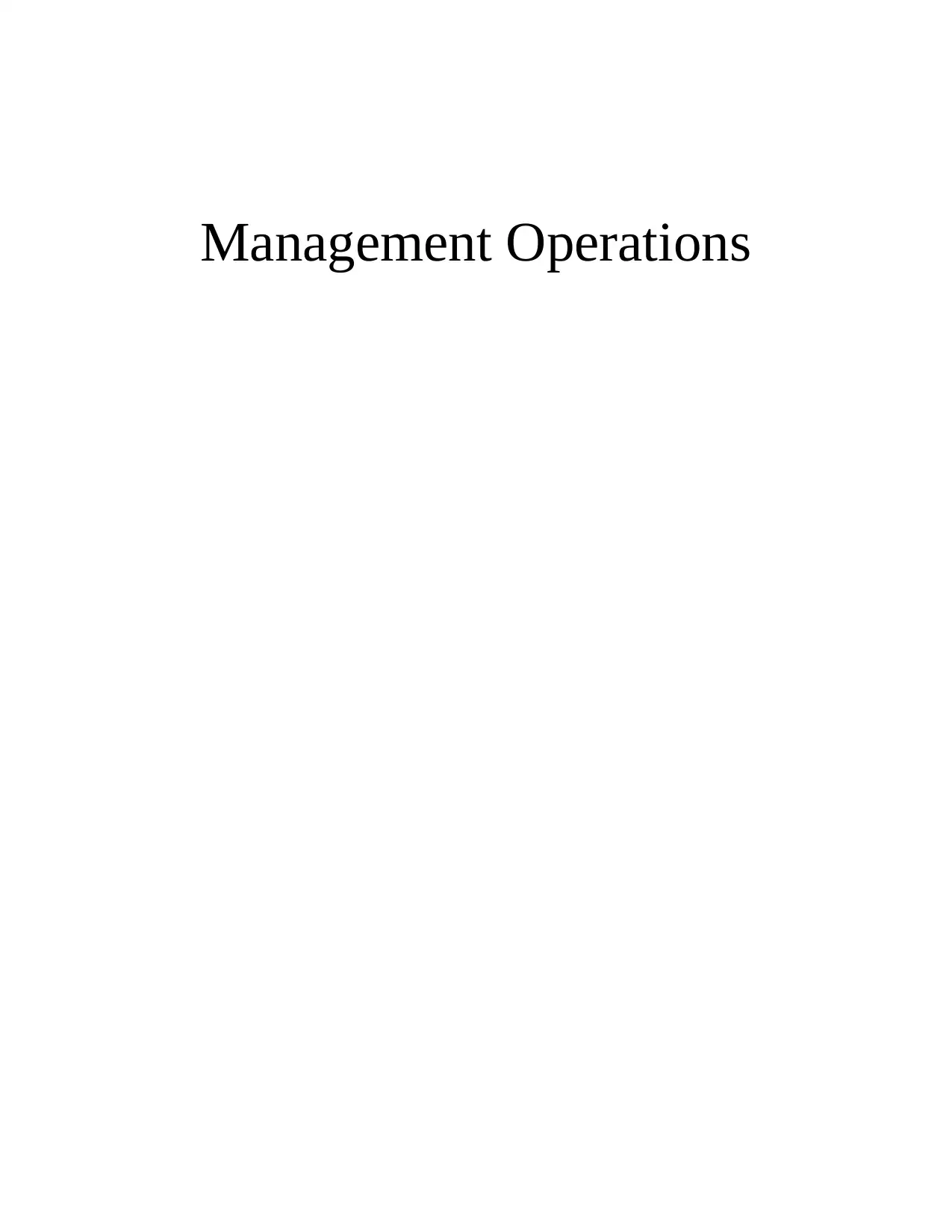
Management Operations
Paraphrase This Document
Need a fresh take? Get an instant paraphrase of this document with our AI Paraphraser
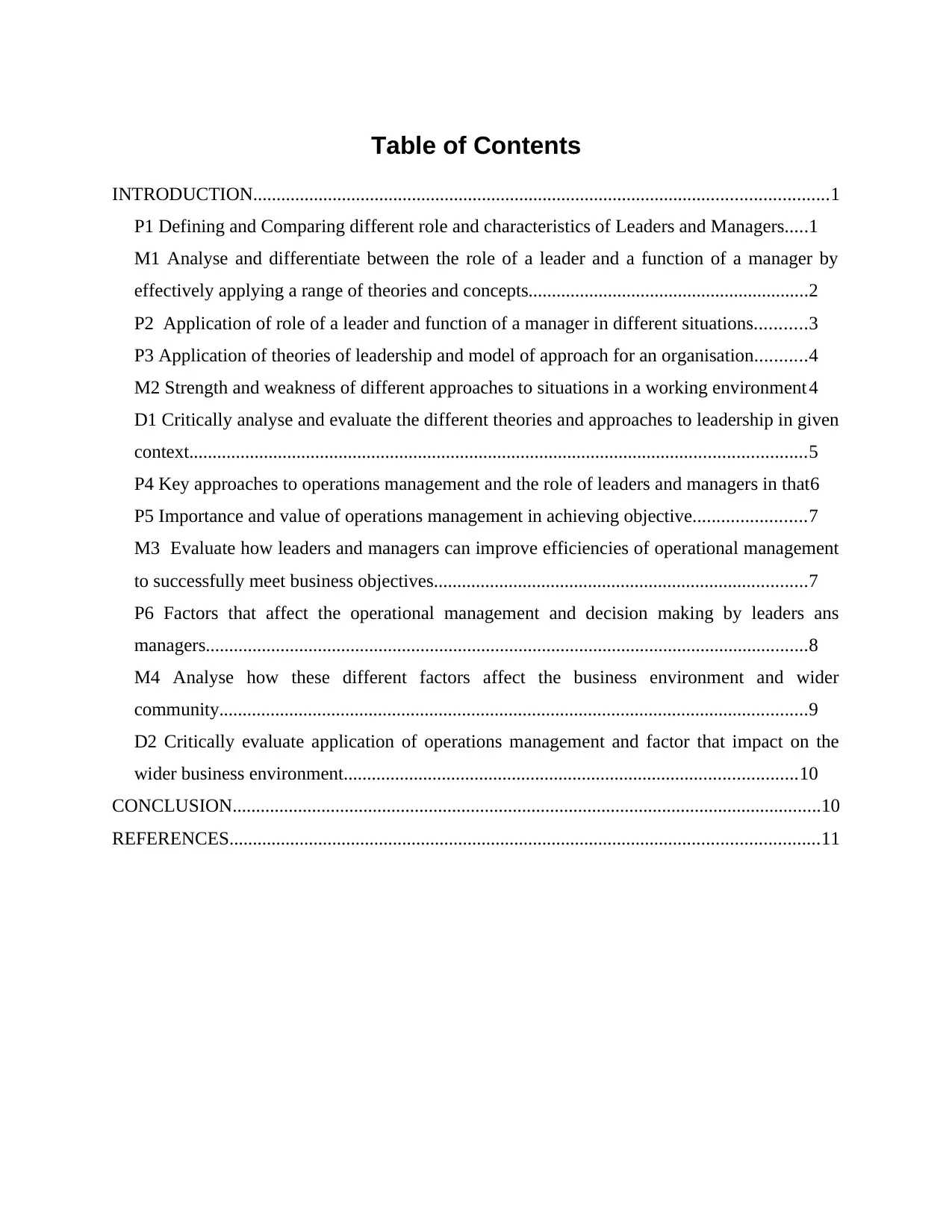
Table of Contents
INTRODUCTION...........................................................................................................................1
P1 Defining and Comparing different role and characteristics of Leaders and Managers.....1
M1 Analyse and differentiate between the role of a leader and a function of a manager by
effectively applying a range of theories and concepts............................................................2
P2 Application of role of a leader and function of a manager in different situations...........3
P3 Application of theories of leadership and model of approach for an organisation...........4
M2 Strength and weakness of different approaches to situations in a working environment 4
D1 Critically analyse and evaluate the different theories and approaches to leadership in given
context....................................................................................................................................5
P4 Key approaches to operations management and the role of leaders and managers in that6
P5 Importance and value of operations management in achieving objective........................7
M3 Evaluate how leaders and managers can improve efficiencies of operational management
to successfully meet business objectives................................................................................7
P6 Factors that affect the operational management and decision making by leaders ans
managers.................................................................................................................................8
M4 Analyse how these different factors affect the business environment and wider
community..............................................................................................................................9
D2 Critically evaluate application of operations management and factor that impact on the
wider business environment.................................................................................................10
CONCLUSION..............................................................................................................................10
REFERENCES..............................................................................................................................11
INTRODUCTION...........................................................................................................................1
P1 Defining and Comparing different role and characteristics of Leaders and Managers.....1
M1 Analyse and differentiate between the role of a leader and a function of a manager by
effectively applying a range of theories and concepts............................................................2
P2 Application of role of a leader and function of a manager in different situations...........3
P3 Application of theories of leadership and model of approach for an organisation...........4
M2 Strength and weakness of different approaches to situations in a working environment 4
D1 Critically analyse and evaluate the different theories and approaches to leadership in given
context....................................................................................................................................5
P4 Key approaches to operations management and the role of leaders and managers in that6
P5 Importance and value of operations management in achieving objective........................7
M3 Evaluate how leaders and managers can improve efficiencies of operational management
to successfully meet business objectives................................................................................7
P6 Factors that affect the operational management and decision making by leaders ans
managers.................................................................................................................................8
M4 Analyse how these different factors affect the business environment and wider
community..............................................................................................................................9
D2 Critically evaluate application of operations management and factor that impact on the
wider business environment.................................................................................................10
CONCLUSION..............................................................................................................................10
REFERENCES..............................................................................................................................11
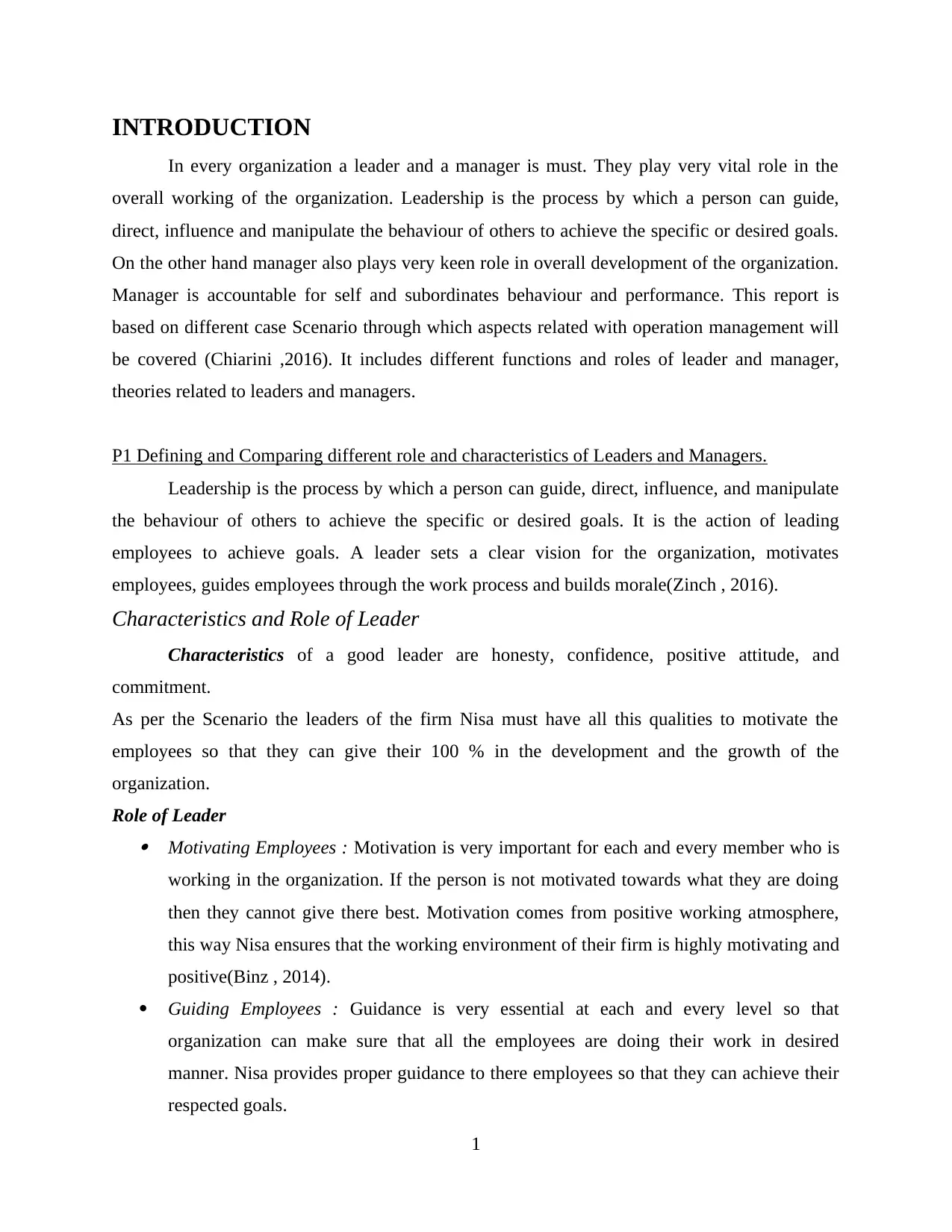
INTRODUCTION
In every organization a leader and a manager is must. They play very vital role in the
overall working of the organization. Leadership is the process by which a person can guide,
direct, influence and manipulate the behaviour of others to achieve the specific or desired goals.
On the other hand manager also plays very keen role in overall development of the organization.
Manager is accountable for self and subordinates behaviour and performance. This report is
based on different case Scenario through which aspects related with operation management will
be covered (Chiarini ,2016). It includes different functions and roles of leader and manager,
theories related to leaders and managers.
P1 Defining and Comparing different role and characteristics of Leaders and Managers.
Leadership is the process by which a person can guide, direct, influence, and manipulate
the behaviour of others to achieve the specific or desired goals. It is the action of leading
employees to achieve goals. A leader sets a clear vision for the organization, motivates
employees, guides employees through the work process and builds morale(Zinch , 2016).
Characteristics and Role of Leader
Characteristics of a good leader are honesty, confidence, positive attitude, and
commitment.
As per the Scenario the leaders of the firm Nisa must have all this qualities to motivate the
employees so that they can give their 100 % in the development and the growth of the
organization.
Role of Leader Motivating Employees : Motivation is very important for each and every member who is
working in the organization. If the person is not motivated towards what they are doing
then they cannot give there best. Motivation comes from positive working atmosphere,
this way Nisa ensures that the working environment of their firm is highly motivating and
positive(Binz , 2014).
Guiding Employees : Guidance is very essential at each and every level so that
organization can make sure that all the employees are doing their work in desired
manner. Nisa provides proper guidance to there employees so that they can achieve their
respected goals.
1
In every organization a leader and a manager is must. They play very vital role in the
overall working of the organization. Leadership is the process by which a person can guide,
direct, influence and manipulate the behaviour of others to achieve the specific or desired goals.
On the other hand manager also plays very keen role in overall development of the organization.
Manager is accountable for self and subordinates behaviour and performance. This report is
based on different case Scenario through which aspects related with operation management will
be covered (Chiarini ,2016). It includes different functions and roles of leader and manager,
theories related to leaders and managers.
P1 Defining and Comparing different role and characteristics of Leaders and Managers.
Leadership is the process by which a person can guide, direct, influence, and manipulate
the behaviour of others to achieve the specific or desired goals. It is the action of leading
employees to achieve goals. A leader sets a clear vision for the organization, motivates
employees, guides employees through the work process and builds morale(Zinch , 2016).
Characteristics and Role of Leader
Characteristics of a good leader are honesty, confidence, positive attitude, and
commitment.
As per the Scenario the leaders of the firm Nisa must have all this qualities to motivate the
employees so that they can give their 100 % in the development and the growth of the
organization.
Role of Leader Motivating Employees : Motivation is very important for each and every member who is
working in the organization. If the person is not motivated towards what they are doing
then they cannot give there best. Motivation comes from positive working atmosphere,
this way Nisa ensures that the working environment of their firm is highly motivating and
positive(Binz , 2014).
Guiding Employees : Guidance is very essential at each and every level so that
organization can make sure that all the employees are doing their work in desired
manner. Nisa provides proper guidance to there employees so that they can achieve their
respected goals.
1
⊘ This is a preview!⊘
Do you want full access?
Subscribe today to unlock all pages.

Trusted by 1+ million students worldwide
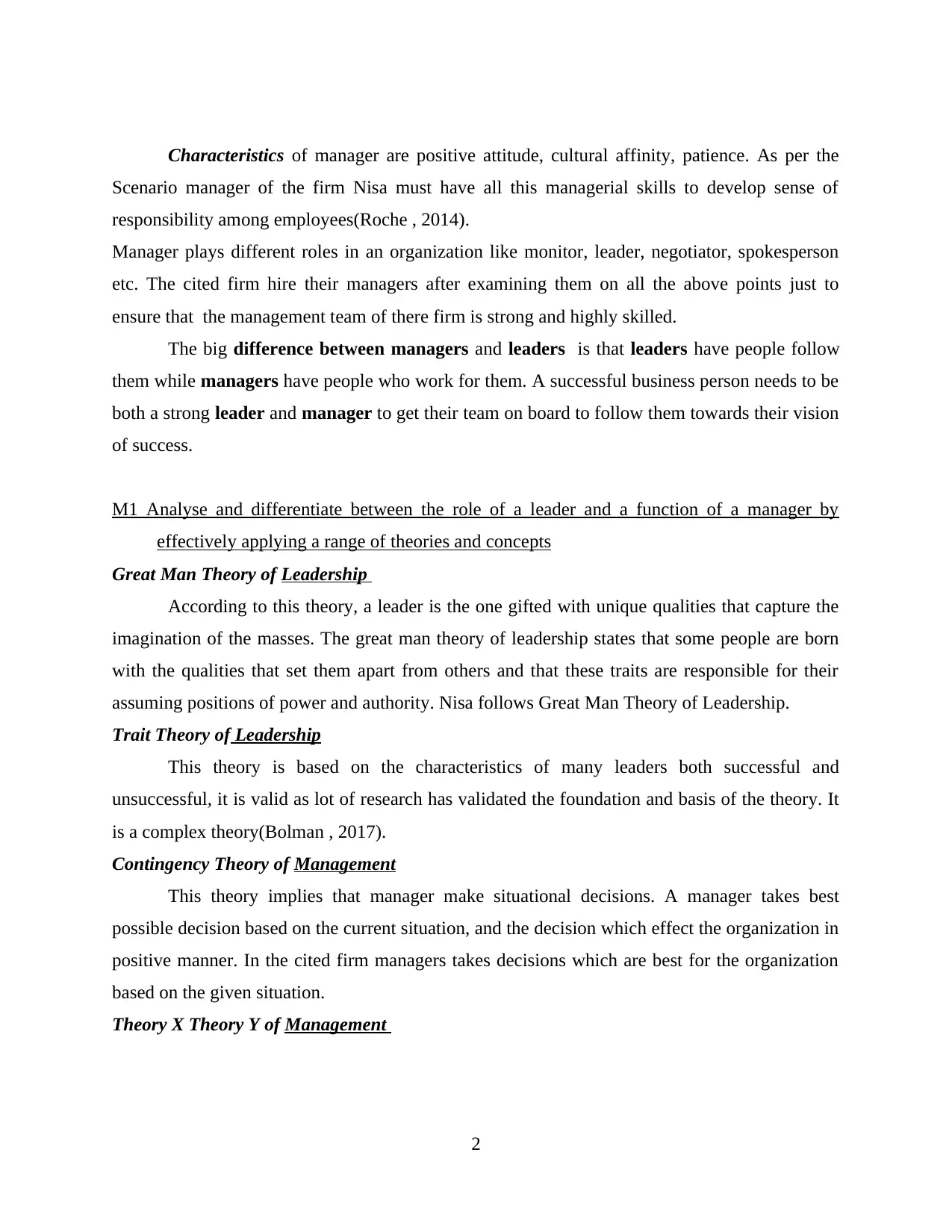
Characteristics of manager are positive attitude, cultural affinity, patience. As per the
Scenario manager of the firm Nisa must have all this managerial skills to develop sense of
responsibility among employees(Roche , 2014).
Manager plays different roles in an organization like monitor, leader, negotiator, spokesperson
etc. The cited firm hire their managers after examining them on all the above points just to
ensure that the management team of there firm is strong and highly skilled.
The big difference between managers and leaders is that leaders have people follow
them while managers have people who work for them. A successful business person needs to be
both a strong leader and manager to get their team on board to follow them towards their vision
of success.
M1 Analyse and differentiate between the role of a leader and a function of a manager by
effectively applying a range of theories and concepts
Great Man Theory of Leadership
According to this theory, a leader is the one gifted with unique qualities that capture the
imagination of the masses. The great man theory of leadership states that some people are born
with the qualities that set them apart from others and that these traits are responsible for their
assuming positions of power and authority. Nisa follows Great Man Theory of Leadership.
Trait Theory of Leadership
This theory is based on the characteristics of many leaders both successful and
unsuccessful, it is valid as lot of research has validated the foundation and basis of the theory. It
is a complex theory(Bolman , 2017).
Contingency Theory of Management
This theory implies that manager make situational decisions. A manager takes best
possible decision based on the current situation, and the decision which effect the organization in
positive manner. In the cited firm managers takes decisions which are best for the organization
based on the given situation.
Theory X Theory Y of Management
2
Scenario manager of the firm Nisa must have all this managerial skills to develop sense of
responsibility among employees(Roche , 2014).
Manager plays different roles in an organization like monitor, leader, negotiator, spokesperson
etc. The cited firm hire their managers after examining them on all the above points just to
ensure that the management team of there firm is strong and highly skilled.
The big difference between managers and leaders is that leaders have people follow
them while managers have people who work for them. A successful business person needs to be
both a strong leader and manager to get their team on board to follow them towards their vision
of success.
M1 Analyse and differentiate between the role of a leader and a function of a manager by
effectively applying a range of theories and concepts
Great Man Theory of Leadership
According to this theory, a leader is the one gifted with unique qualities that capture the
imagination of the masses. The great man theory of leadership states that some people are born
with the qualities that set them apart from others and that these traits are responsible for their
assuming positions of power and authority. Nisa follows Great Man Theory of Leadership.
Trait Theory of Leadership
This theory is based on the characteristics of many leaders both successful and
unsuccessful, it is valid as lot of research has validated the foundation and basis of the theory. It
is a complex theory(Bolman , 2017).
Contingency Theory of Management
This theory implies that manager make situational decisions. A manager takes best
possible decision based on the current situation, and the decision which effect the organization in
positive manner. In the cited firm managers takes decisions which are best for the organization
based on the given situation.
Theory X Theory Y of Management
2
Paraphrase This Document
Need a fresh take? Get an instant paraphrase of this document with our AI Paraphraser
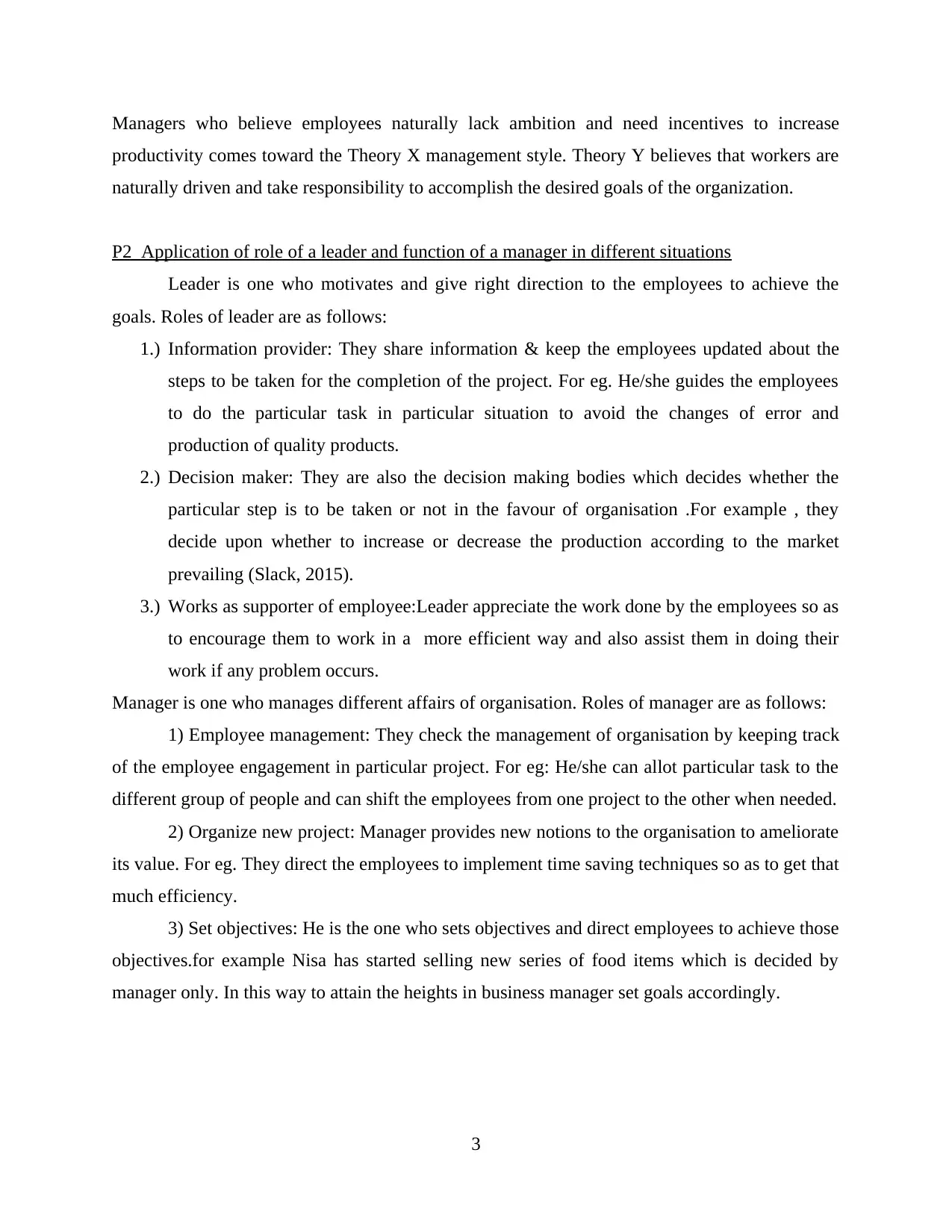
Managers who believe employees naturally lack ambition and need incentives to increase
productivity comes toward the Theory X management style. Theory Y believes that workers are
naturally driven and take responsibility to accomplish the desired goals of the organization.
P2 Application of role of a leader and function of a manager in different situations
Leader is one who motivates and give right direction to the employees to achieve the
goals. Roles of leader are as follows:
1.) Information provider: They share information & keep the employees updated about the
steps to be taken for the completion of the project. For eg. He/she guides the employees
to do the particular task in particular situation to avoid the changes of error and
production of quality products.
2.) Decision maker: They are also the decision making bodies which decides whether the
particular step is to be taken or not in the favour of organisation .For example , they
decide upon whether to increase or decrease the production according to the market
prevailing (Slack, 2015).
3.) Works as supporter of employee:Leader appreciate the work done by the employees so as
to encourage them to work in a more efficient way and also assist them in doing their
work if any problem occurs.
Manager is one who manages different affairs of organisation. Roles of manager are as follows:
1) Employee management: They check the management of organisation by keeping track
of the employee engagement in particular project. For eg: He/she can allot particular task to the
different group of people and can shift the employees from one project to the other when needed.
2) Organize new project: Manager provides new notions to the organisation to ameliorate
its value. For eg. They direct the employees to implement time saving techniques so as to get that
much efficiency.
3) Set objectives: He is the one who sets objectives and direct employees to achieve those
objectives.for example Nisa has started selling new series of food items which is decided by
manager only. In this way to attain the heights in business manager set goals accordingly.
3
productivity comes toward the Theory X management style. Theory Y believes that workers are
naturally driven and take responsibility to accomplish the desired goals of the organization.
P2 Application of role of a leader and function of a manager in different situations
Leader is one who motivates and give right direction to the employees to achieve the
goals. Roles of leader are as follows:
1.) Information provider: They share information & keep the employees updated about the
steps to be taken for the completion of the project. For eg. He/she guides the employees
to do the particular task in particular situation to avoid the changes of error and
production of quality products.
2.) Decision maker: They are also the decision making bodies which decides whether the
particular step is to be taken or not in the favour of organisation .For example , they
decide upon whether to increase or decrease the production according to the market
prevailing (Slack, 2015).
3.) Works as supporter of employee:Leader appreciate the work done by the employees so as
to encourage them to work in a more efficient way and also assist them in doing their
work if any problem occurs.
Manager is one who manages different affairs of organisation. Roles of manager are as follows:
1) Employee management: They check the management of organisation by keeping track
of the employee engagement in particular project. For eg: He/she can allot particular task to the
different group of people and can shift the employees from one project to the other when needed.
2) Organize new project: Manager provides new notions to the organisation to ameliorate
its value. For eg. They direct the employees to implement time saving techniques so as to get that
much efficiency.
3) Set objectives: He is the one who sets objectives and direct employees to achieve those
objectives.for example Nisa has started selling new series of food items which is decided by
manager only. In this way to attain the heights in business manager set goals accordingly.
3
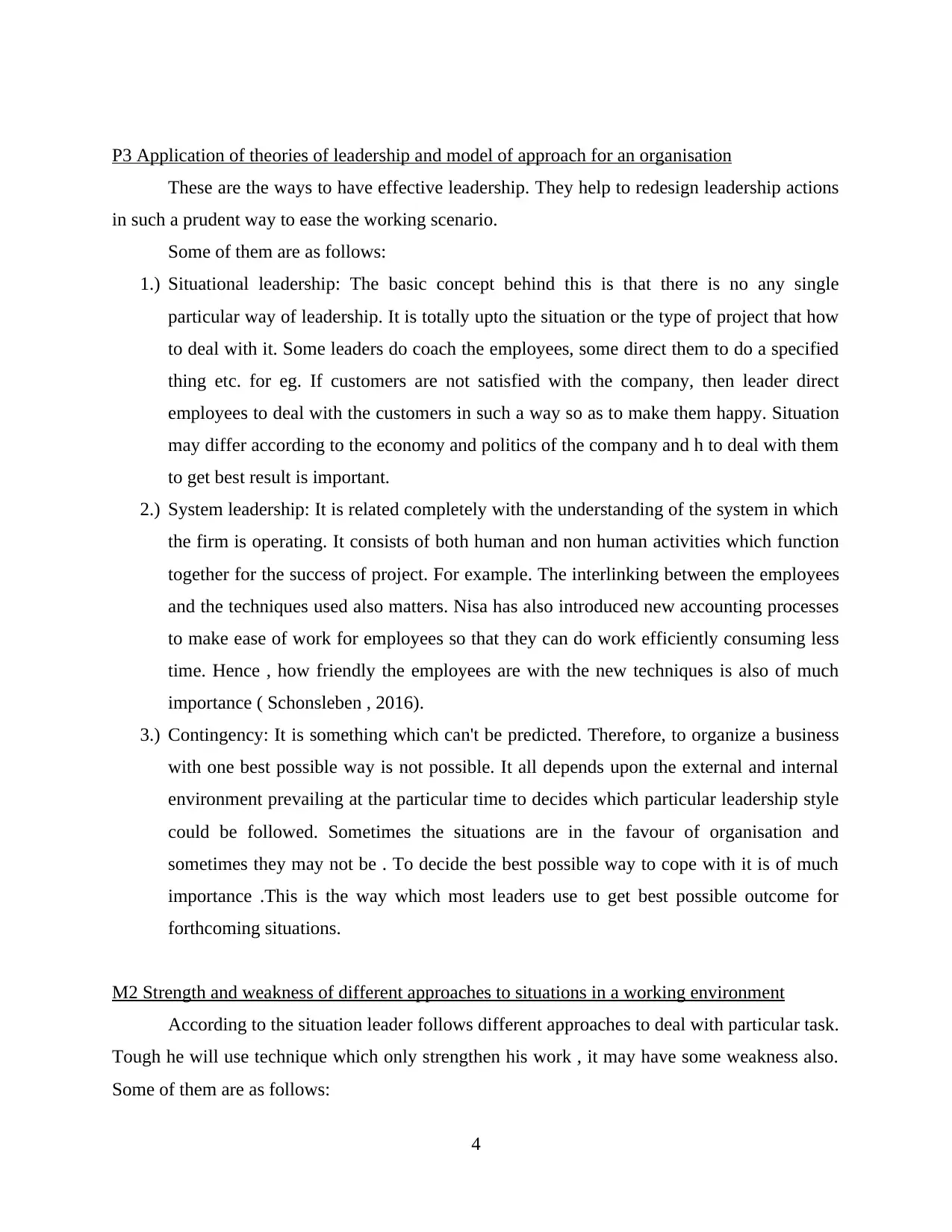
P3 Application of theories of leadership and model of approach for an organisation
These are the ways to have effective leadership. They help to redesign leadership actions
in such a prudent way to ease the working scenario.
Some of them are as follows:
1.) Situational leadership: The basic concept behind this is that there is no any single
particular way of leadership. It is totally upto the situation or the type of project that how
to deal with it. Some leaders do coach the employees, some direct them to do a specified
thing etc. for eg. If customers are not satisfied with the company, then leader direct
employees to deal with the customers in such a way so as to make them happy. Situation
may differ according to the economy and politics of the company and h to deal with them
to get best result is important.
2.) System leadership: It is related completely with the understanding of the system in which
the firm is operating. It consists of both human and non human activities which function
together for the success of project. For example. The interlinking between the employees
and the techniques used also matters. Nisa has also introduced new accounting processes
to make ease of work for employees so that they can do work efficiently consuming less
time. Hence , how friendly the employees are with the new techniques is also of much
importance ( Schonsleben , 2016).
3.) Contingency: It is something which can't be predicted. Therefore, to organize a business
with one best possible way is not possible. It all depends upon the external and internal
environment prevailing at the particular time to decides which particular leadership style
could be followed. Sometimes the situations are in the favour of organisation and
sometimes they may not be . To decide the best possible way to cope with it is of much
importance .This is the way which most leaders use to get best possible outcome for
forthcoming situations.
M2 Strength and weakness of different approaches to situations in a working environment
According to the situation leader follows different approaches to deal with particular task.
Tough he will use technique which only strengthen his work , it may have some weakness also.
Some of them are as follows:
4
These are the ways to have effective leadership. They help to redesign leadership actions
in such a prudent way to ease the working scenario.
Some of them are as follows:
1.) Situational leadership: The basic concept behind this is that there is no any single
particular way of leadership. It is totally upto the situation or the type of project that how
to deal with it. Some leaders do coach the employees, some direct them to do a specified
thing etc. for eg. If customers are not satisfied with the company, then leader direct
employees to deal with the customers in such a way so as to make them happy. Situation
may differ according to the economy and politics of the company and h to deal with them
to get best result is important.
2.) System leadership: It is related completely with the understanding of the system in which
the firm is operating. It consists of both human and non human activities which function
together for the success of project. For example. The interlinking between the employees
and the techniques used also matters. Nisa has also introduced new accounting processes
to make ease of work for employees so that they can do work efficiently consuming less
time. Hence , how friendly the employees are with the new techniques is also of much
importance ( Schonsleben , 2016).
3.) Contingency: It is something which can't be predicted. Therefore, to organize a business
with one best possible way is not possible. It all depends upon the external and internal
environment prevailing at the particular time to decides which particular leadership style
could be followed. Sometimes the situations are in the favour of organisation and
sometimes they may not be . To decide the best possible way to cope with it is of much
importance .This is the way which most leaders use to get best possible outcome for
forthcoming situations.
M2 Strength and weakness of different approaches to situations in a working environment
According to the situation leader follows different approaches to deal with particular task.
Tough he will use technique which only strengthen his work , it may have some weakness also.
Some of them are as follows:
4
⊘ This is a preview!⊘
Do you want full access?
Subscribe today to unlock all pages.

Trusted by 1+ million students worldwide
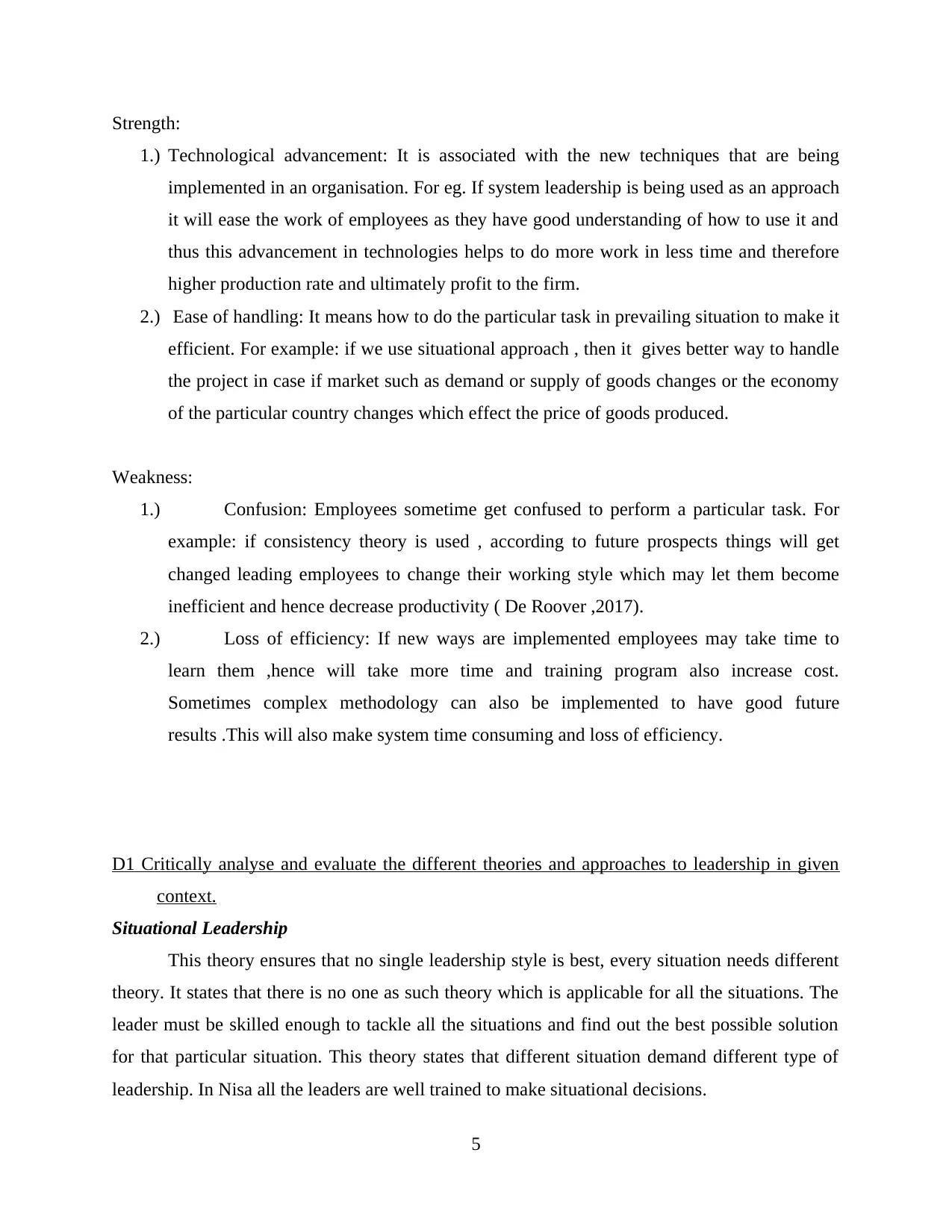
Strength:
1.) Technological advancement: It is associated with the new techniques that are being
implemented in an organisation. For eg. If system leadership is being used as an approach
it will ease the work of employees as they have good understanding of how to use it and
thus this advancement in technologies helps to do more work in less time and therefore
higher production rate and ultimately profit to the firm.
2.) Ease of handling: It means how to do the particular task in prevailing situation to make it
efficient. For example: if we use situational approach , then it gives better way to handle
the project in case if market such as demand or supply of goods changes or the economy
of the particular country changes which effect the price of goods produced.
Weakness:
1.) Confusion: Employees sometime get confused to perform a particular task. For
example: if consistency theory is used , according to future prospects things will get
changed leading employees to change their working style which may let them become
inefficient and hence decrease productivity ( De Roover ,2017).
2.) Loss of efficiency: If new ways are implemented employees may take time to
learn them ,hence will take more time and training program also increase cost.
Sometimes complex methodology can also be implemented to have good future
results .This will also make system time consuming and loss of efficiency.
D1 Critically analyse and evaluate the different theories and approaches to leadership in given
context.
Situational Leadership
This theory ensures that no single leadership style is best, every situation needs different
theory. It states that there is no one as such theory which is applicable for all the situations. The
leader must be skilled enough to tackle all the situations and find out the best possible solution
for that particular situation. This theory states that different situation demand different type of
leadership. In Nisa all the leaders are well trained to make situational decisions.
5
1.) Technological advancement: It is associated with the new techniques that are being
implemented in an organisation. For eg. If system leadership is being used as an approach
it will ease the work of employees as they have good understanding of how to use it and
thus this advancement in technologies helps to do more work in less time and therefore
higher production rate and ultimately profit to the firm.
2.) Ease of handling: It means how to do the particular task in prevailing situation to make it
efficient. For example: if we use situational approach , then it gives better way to handle
the project in case if market such as demand or supply of goods changes or the economy
of the particular country changes which effect the price of goods produced.
Weakness:
1.) Confusion: Employees sometime get confused to perform a particular task. For
example: if consistency theory is used , according to future prospects things will get
changed leading employees to change their working style which may let them become
inefficient and hence decrease productivity ( De Roover ,2017).
2.) Loss of efficiency: If new ways are implemented employees may take time to
learn them ,hence will take more time and training program also increase cost.
Sometimes complex methodology can also be implemented to have good future
results .This will also make system time consuming and loss of efficiency.
D1 Critically analyse and evaluate the different theories and approaches to leadership in given
context.
Situational Leadership
This theory ensures that no single leadership style is best, every situation needs different
theory. It states that there is no one as such theory which is applicable for all the situations. The
leader must be skilled enough to tackle all the situations and find out the best possible solution
for that particular situation. This theory states that different situation demand different type of
leadership. In Nisa all the leaders are well trained to make situational decisions.
5
Paraphrase This Document
Need a fresh take? Get an instant paraphrase of this document with our AI Paraphraser
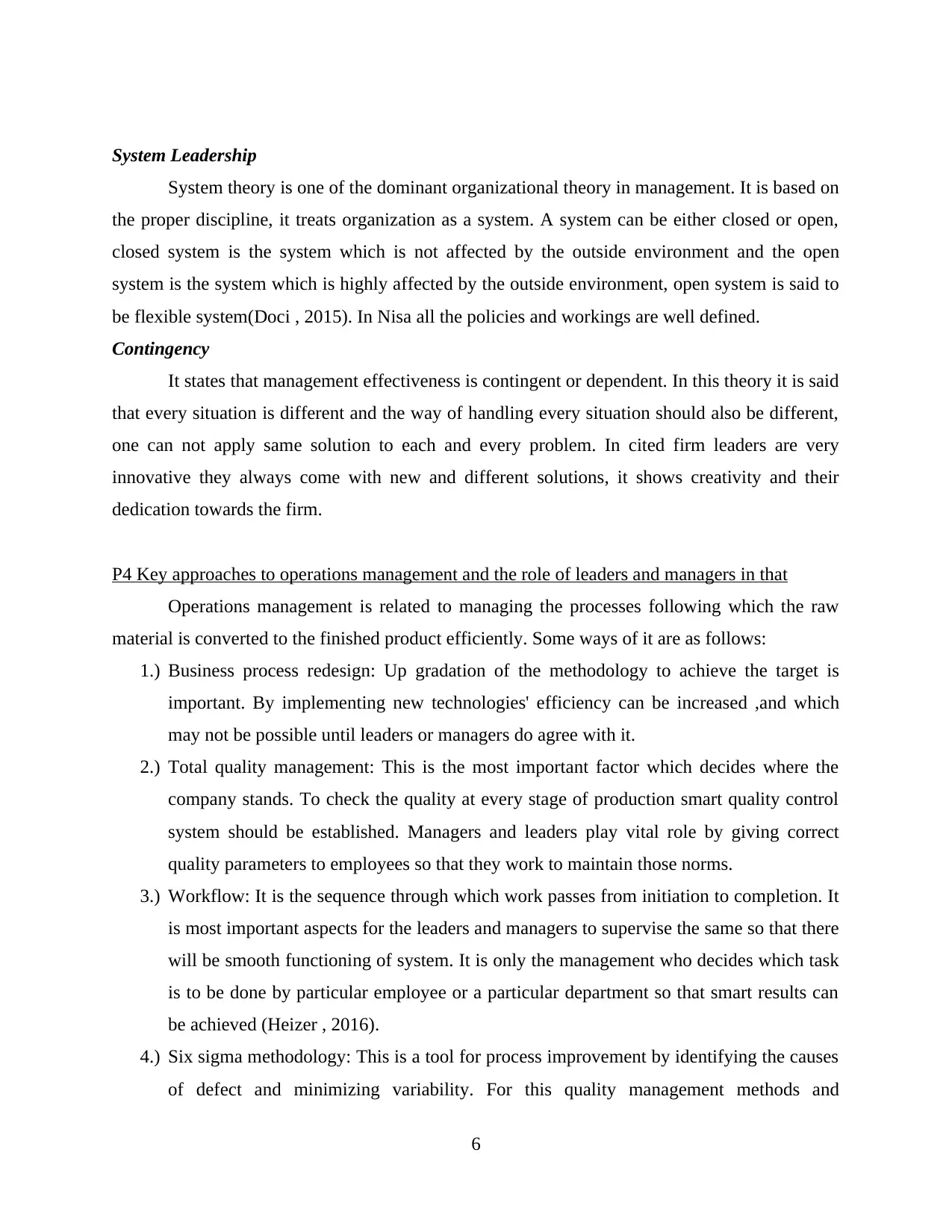
System Leadership
System theory is one of the dominant organizational theory in management. It is based on
the proper discipline, it treats organization as a system. A system can be either closed or open,
closed system is the system which is not affected by the outside environment and the open
system is the system which is highly affected by the outside environment, open system is said to
be flexible system(Doci , 2015). In Nisa all the policies and workings are well defined.
Contingency
It states that management effectiveness is contingent or dependent. In this theory it is said
that every situation is different and the way of handling every situation should also be different,
one can not apply same solution to each and every problem. In cited firm leaders are very
innovative they always come with new and different solutions, it shows creativity and their
dedication towards the firm.
P4 Key approaches to operations management and the role of leaders and managers in that
Operations management is related to managing the processes following which the raw
material is converted to the finished product efficiently. Some ways of it are as follows:
1.) Business process redesign: Up gradation of the methodology to achieve the target is
important. By implementing new technologies' efficiency can be increased ,and which
may not be possible until leaders or managers do agree with it.
2.) Total quality management: This is the most important factor which decides where the
company stands. To check the quality at every stage of production smart quality control
system should be established. Managers and leaders play vital role by giving correct
quality parameters to employees so that they work to maintain those norms.
3.) Workflow: It is the sequence through which work passes from initiation to completion. It
is most important aspects for the leaders and managers to supervise the same so that there
will be smooth functioning of system. It is only the management who decides which task
is to be done by particular employee or a particular department so that smart results can
be achieved (Heizer , 2016).
4.) Six sigma methodology: This is a tool for process improvement by identifying the causes
of defect and minimizing variability. For this quality management methods and
6
System theory is one of the dominant organizational theory in management. It is based on
the proper discipline, it treats organization as a system. A system can be either closed or open,
closed system is the system which is not affected by the outside environment and the open
system is the system which is highly affected by the outside environment, open system is said to
be flexible system(Doci , 2015). In Nisa all the policies and workings are well defined.
Contingency
It states that management effectiveness is contingent or dependent. In this theory it is said
that every situation is different and the way of handling every situation should also be different,
one can not apply same solution to each and every problem. In cited firm leaders are very
innovative they always come with new and different solutions, it shows creativity and their
dedication towards the firm.
P4 Key approaches to operations management and the role of leaders and managers in that
Operations management is related to managing the processes following which the raw
material is converted to the finished product efficiently. Some ways of it are as follows:
1.) Business process redesign: Up gradation of the methodology to achieve the target is
important. By implementing new technologies' efficiency can be increased ,and which
may not be possible until leaders or managers do agree with it.
2.) Total quality management: This is the most important factor which decides where the
company stands. To check the quality at every stage of production smart quality control
system should be established. Managers and leaders play vital role by giving correct
quality parameters to employees so that they work to maintain those norms.
3.) Workflow: It is the sequence through which work passes from initiation to completion. It
is most important aspects for the leaders and managers to supervise the same so that there
will be smooth functioning of system. It is only the management who decides which task
is to be done by particular employee or a particular department so that smart results can
be achieved (Heizer , 2016).
4.) Six sigma methodology: This is a tool for process improvement by identifying the causes
of defect and minimizing variability. For this quality management methods and
6
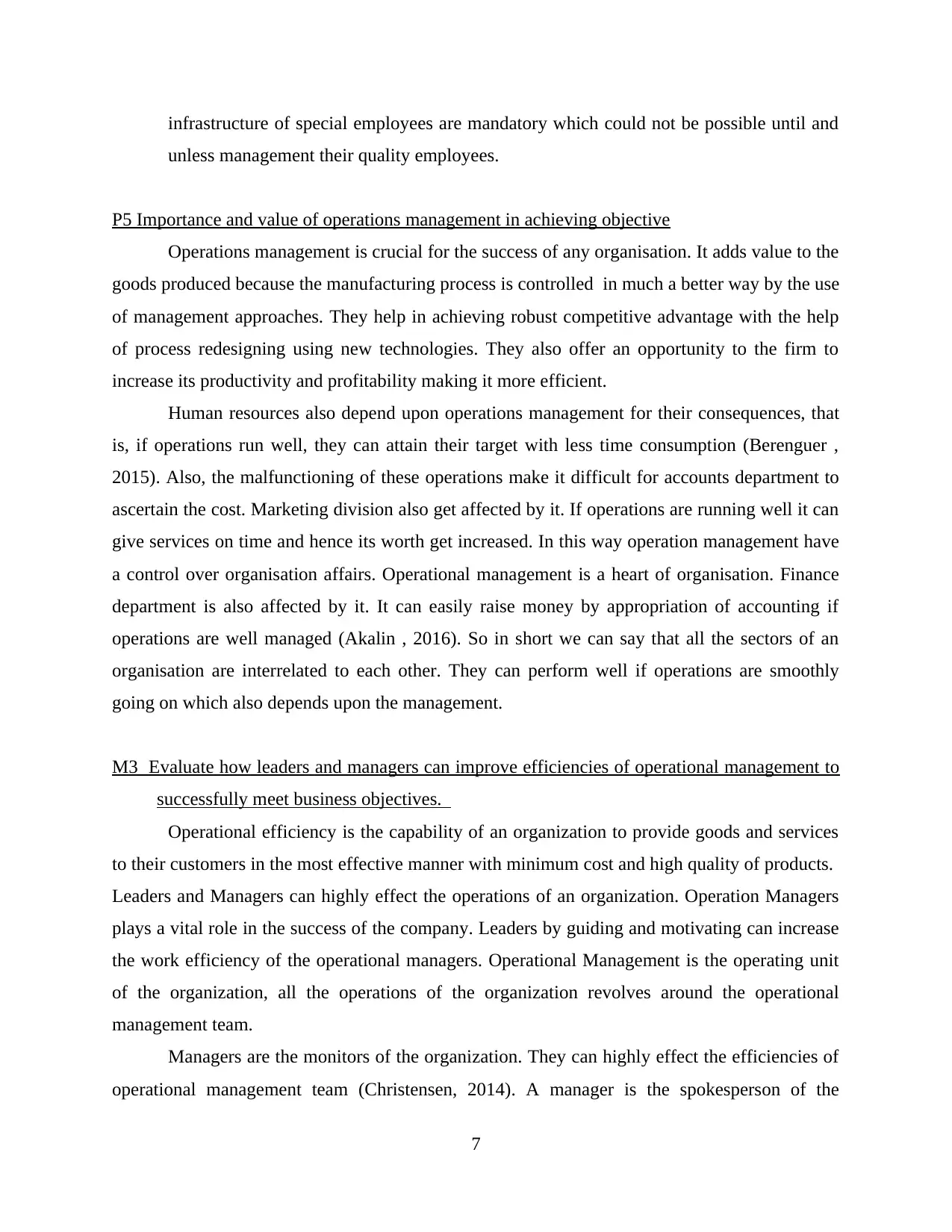
infrastructure of special employees are mandatory which could not be possible until and
unless management their quality employees.
P5 Importance and value of operations management in achieving objective
Operations management is crucial for the success of any organisation. It adds value to the
goods produced because the manufacturing process is controlled in much a better way by the use
of management approaches. They help in achieving robust competitive advantage with the help
of process redesigning using new technologies. They also offer an opportunity to the firm to
increase its productivity and profitability making it more efficient.
Human resources also depend upon operations management for their consequences, that
is, if operations run well, they can attain their target with less time consumption (Berenguer ,
2015). Also, the malfunctioning of these operations make it difficult for accounts department to
ascertain the cost. Marketing division also get affected by it. If operations are running well it can
give services on time and hence its worth get increased. In this way operation management have
a control over organisation affairs. Operational management is a heart of organisation. Finance
department is also affected by it. It can easily raise money by appropriation of accounting if
operations are well managed (Akalin , 2016). So in short we can say that all the sectors of an
organisation are interrelated to each other. They can perform well if operations are smoothly
going on which also depends upon the management.
M3 Evaluate how leaders and managers can improve efficiencies of operational management to
successfully meet business objectives.
Operational efficiency is the capability of an organization to provide goods and services
to their customers in the most effective manner with minimum cost and high quality of products.
Leaders and Managers can highly effect the operations of an organization. Operation Managers
plays a vital role in the success of the company. Leaders by guiding and motivating can increase
the work efficiency of the operational managers. Operational Management is the operating unit
of the organization, all the operations of the organization revolves around the operational
management team.
Managers are the monitors of the organization. They can highly effect the efficiencies of
operational management team (Christensen, 2014). A manager is the spokesperson of the
7
unless management their quality employees.
P5 Importance and value of operations management in achieving objective
Operations management is crucial for the success of any organisation. It adds value to the
goods produced because the manufacturing process is controlled in much a better way by the use
of management approaches. They help in achieving robust competitive advantage with the help
of process redesigning using new technologies. They also offer an opportunity to the firm to
increase its productivity and profitability making it more efficient.
Human resources also depend upon operations management for their consequences, that
is, if operations run well, they can attain their target with less time consumption (Berenguer ,
2015). Also, the malfunctioning of these operations make it difficult for accounts department to
ascertain the cost. Marketing division also get affected by it. If operations are running well it can
give services on time and hence its worth get increased. In this way operation management have
a control over organisation affairs. Operational management is a heart of organisation. Finance
department is also affected by it. It can easily raise money by appropriation of accounting if
operations are well managed (Akalin , 2016). So in short we can say that all the sectors of an
organisation are interrelated to each other. They can perform well if operations are smoothly
going on which also depends upon the management.
M3 Evaluate how leaders and managers can improve efficiencies of operational management to
successfully meet business objectives.
Operational efficiency is the capability of an organization to provide goods and services
to their customers in the most effective manner with minimum cost and high quality of products.
Leaders and Managers can highly effect the operations of an organization. Operation Managers
plays a vital role in the success of the company. Leaders by guiding and motivating can increase
the work efficiency of the operational managers. Operational Management is the operating unit
of the organization, all the operations of the organization revolves around the operational
management team.
Managers are the monitors of the organization. They can highly effect the efficiencies of
operational management team (Christensen, 2014). A manager is the spokesperson of the
7
⊘ This is a preview!⊘
Do you want full access?
Subscribe today to unlock all pages.

Trusted by 1+ million students worldwide
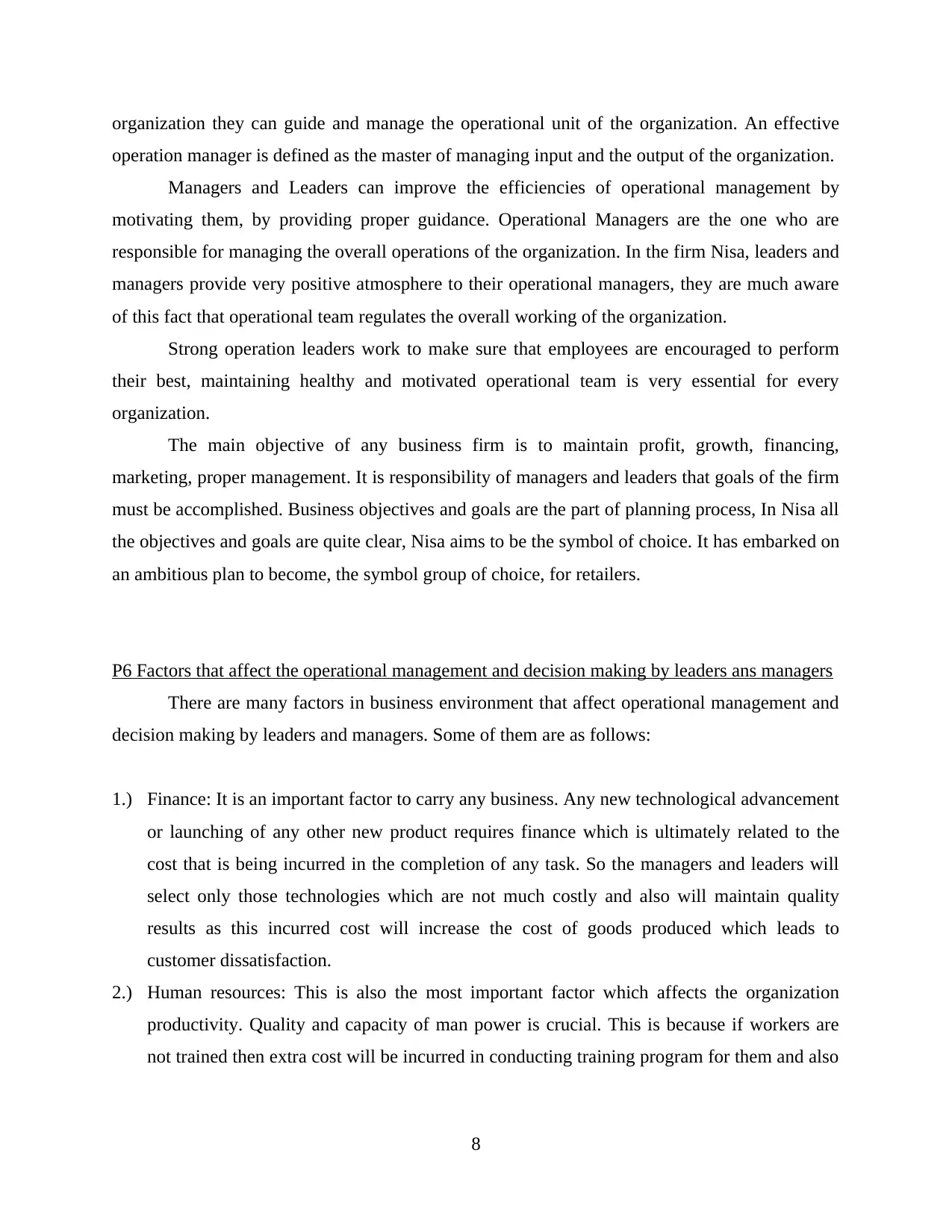
organization they can guide and manage the operational unit of the organization. An effective
operation manager is defined as the master of managing input and the output of the organization.
Managers and Leaders can improve the efficiencies of operational management by
motivating them, by providing proper guidance. Operational Managers are the one who are
responsible for managing the overall operations of the organization. In the firm Nisa, leaders and
managers provide very positive atmosphere to their operational managers, they are much aware
of this fact that operational team regulates the overall working of the organization.
Strong operation leaders work to make sure that employees are encouraged to perform
their best, maintaining healthy and motivated operational team is very essential for every
organization.
The main objective of any business firm is to maintain profit, growth, financing,
marketing, proper management. It is responsibility of managers and leaders that goals of the firm
must be accomplished. Business objectives and goals are the part of planning process, In Nisa all
the objectives and goals are quite clear, Nisa aims to be the symbol of choice. It has embarked on
an ambitious plan to become, the symbol group of choice, for retailers.
P6 Factors that affect the operational management and decision making by leaders ans managers
There are many factors in business environment that affect operational management and
decision making by leaders and managers. Some of them are as follows:
1.) Finance: It is an important factor to carry any business. Any new technological advancement
or launching of any other new product requires finance which is ultimately related to the
cost that is being incurred in the completion of any task. So the managers and leaders will
select only those technologies which are not much costly and also will maintain quality
results as this incurred cost will increase the cost of goods produced which leads to
customer dissatisfaction.
2.) Human resources: This is also the most important factor which affects the organization
productivity. Quality and capacity of man power is crucial. This is because if workers are
not trained then extra cost will be incurred in conducting training program for them and also
8
operation manager is defined as the master of managing input and the output of the organization.
Managers and Leaders can improve the efficiencies of operational management by
motivating them, by providing proper guidance. Operational Managers are the one who are
responsible for managing the overall operations of the organization. In the firm Nisa, leaders and
managers provide very positive atmosphere to their operational managers, they are much aware
of this fact that operational team regulates the overall working of the organization.
Strong operation leaders work to make sure that employees are encouraged to perform
their best, maintaining healthy and motivated operational team is very essential for every
organization.
The main objective of any business firm is to maintain profit, growth, financing,
marketing, proper management. It is responsibility of managers and leaders that goals of the firm
must be accomplished. Business objectives and goals are the part of planning process, In Nisa all
the objectives and goals are quite clear, Nisa aims to be the symbol of choice. It has embarked on
an ambitious plan to become, the symbol group of choice, for retailers.
P6 Factors that affect the operational management and decision making by leaders ans managers
There are many factors in business environment that affect operational management and
decision making by leaders and managers. Some of them are as follows:
1.) Finance: It is an important factor to carry any business. Any new technological advancement
or launching of any other new product requires finance which is ultimately related to the
cost that is being incurred in the completion of any task. So the managers and leaders will
select only those technologies which are not much costly and also will maintain quality
results as this incurred cost will increase the cost of goods produced which leads to
customer dissatisfaction.
2.) Human resources: This is also the most important factor which affects the organization
productivity. Quality and capacity of man power is crucial. This is because if workers are
not trained then extra cost will be incurred in conducting training program for them and also
8
Paraphrase This Document
Need a fresh take? Get an instant paraphrase of this document with our AI Paraphraser
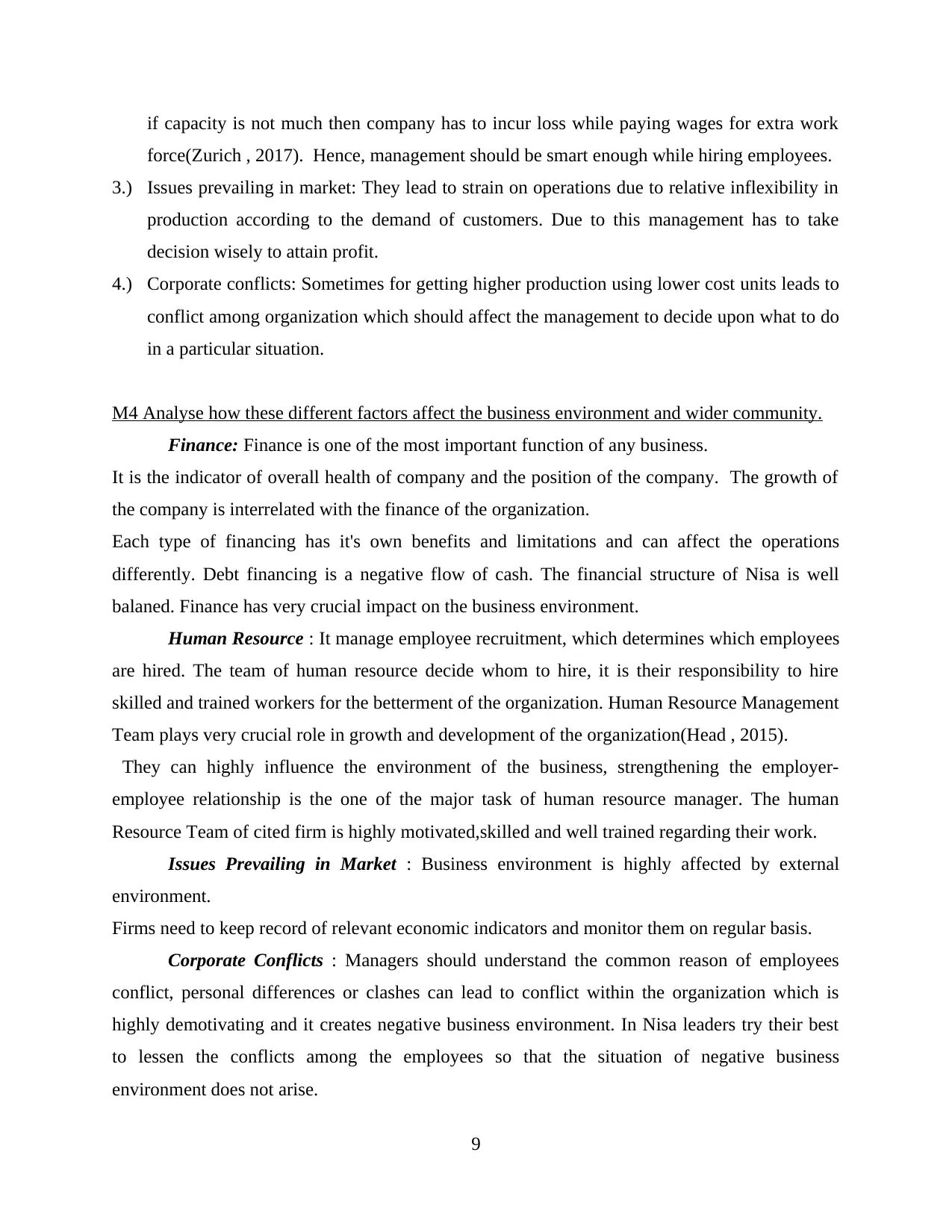
if capacity is not much then company has to incur loss while paying wages for extra work
force(Zurich , 2017). Hence, management should be smart enough while hiring employees.
3.) Issues prevailing in market: They lead to strain on operations due to relative inflexibility in
production according to the demand of customers. Due to this management has to take
decision wisely to attain profit.
4.) Corporate conflicts: Sometimes for getting higher production using lower cost units leads to
conflict among organization which should affect the management to decide upon what to do
in a particular situation.
M4 Analyse how these different factors affect the business environment and wider community.
Finance: Finance is one of the most important function of any business.
It is the indicator of overall health of company and the position of the company. The growth of
the company is interrelated with the finance of the organization.
Each type of financing has it's own benefits and limitations and can affect the operations
differently. Debt financing is a negative flow of cash. The financial structure of Nisa is well
balaned. Finance has very crucial impact on the business environment.
Human Resource : It manage employee recruitment, which determines which employees
are hired. The team of human resource decide whom to hire, it is their responsibility to hire
skilled and trained workers for the betterment of the organization. Human Resource Management
Team plays very crucial role in growth and development of the organization(Head , 2015).
They can highly influence the environment of the business, strengthening the employer-
employee relationship is the one of the major task of human resource manager. The human
Resource Team of cited firm is highly motivated,skilled and well trained regarding their work.
Issues Prevailing in Market : Business environment is highly affected by external
environment.
Firms need to keep record of relevant economic indicators and monitor them on regular basis.
Corporate Conflicts : Managers should understand the common reason of employees
conflict, personal differences or clashes can lead to conflict within the organization which is
highly demotivating and it creates negative business environment. In Nisa leaders try their best
to lessen the conflicts among the employees so that the situation of negative business
environment does not arise.
9
force(Zurich , 2017). Hence, management should be smart enough while hiring employees.
3.) Issues prevailing in market: They lead to strain on operations due to relative inflexibility in
production according to the demand of customers. Due to this management has to take
decision wisely to attain profit.
4.) Corporate conflicts: Sometimes for getting higher production using lower cost units leads to
conflict among organization which should affect the management to decide upon what to do
in a particular situation.
M4 Analyse how these different factors affect the business environment and wider community.
Finance: Finance is one of the most important function of any business.
It is the indicator of overall health of company and the position of the company. The growth of
the company is interrelated with the finance of the organization.
Each type of financing has it's own benefits and limitations and can affect the operations
differently. Debt financing is a negative flow of cash. The financial structure of Nisa is well
balaned. Finance has very crucial impact on the business environment.
Human Resource : It manage employee recruitment, which determines which employees
are hired. The team of human resource decide whom to hire, it is their responsibility to hire
skilled and trained workers for the betterment of the organization. Human Resource Management
Team plays very crucial role in growth and development of the organization(Head , 2015).
They can highly influence the environment of the business, strengthening the employer-
employee relationship is the one of the major task of human resource manager. The human
Resource Team of cited firm is highly motivated,skilled and well trained regarding their work.
Issues Prevailing in Market : Business environment is highly affected by external
environment.
Firms need to keep record of relevant economic indicators and monitor them on regular basis.
Corporate Conflicts : Managers should understand the common reason of employees
conflict, personal differences or clashes can lead to conflict within the organization which is
highly demotivating and it creates negative business environment. In Nisa leaders try their best
to lessen the conflicts among the employees so that the situation of negative business
environment does not arise.
9
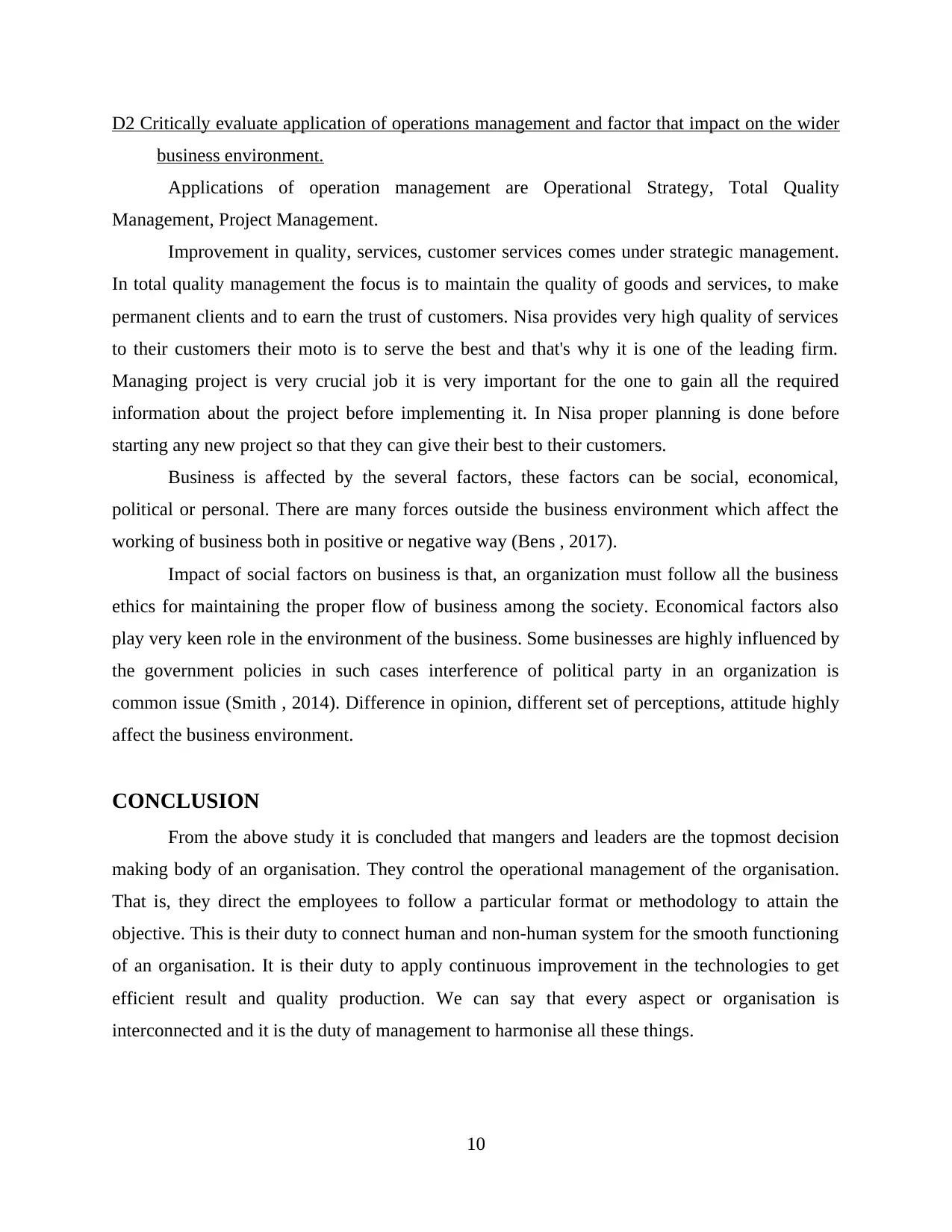
D2 Critically evaluate application of operations management and factor that impact on the wider
business environment.
Applications of operation management are Operational Strategy, Total Quality
Management, Project Management.
Improvement in quality, services, customer services comes under strategic management.
In total quality management the focus is to maintain the quality of goods and services, to make
permanent clients and to earn the trust of customers. Nisa provides very high quality of services
to their customers their moto is to serve the best and that's why it is one of the leading firm.
Managing project is very crucial job it is very important for the one to gain all the required
information about the project before implementing it. In Nisa proper planning is done before
starting any new project so that they can give their best to their customers.
Business is affected by the several factors, these factors can be social, economical,
political or personal. There are many forces outside the business environment which affect the
working of business both in positive or negative way (Bens , 2017).
Impact of social factors on business is that, an organization must follow all the business
ethics for maintaining the proper flow of business among the society. Economical factors also
play very keen role in the environment of the business. Some businesses are highly influenced by
the government policies in such cases interference of political party in an organization is
common issue (Smith , 2014). Difference in opinion, different set of perceptions, attitude highly
affect the business environment.
CONCLUSION
From the above study it is concluded that mangers and leaders are the topmost decision
making body of an organisation. They control the operational management of the organisation.
That is, they direct the employees to follow a particular format or methodology to attain the
objective. This is their duty to connect human and non-human system for the smooth functioning
of an organisation. It is their duty to apply continuous improvement in the technologies to get
efficient result and quality production. We can say that every aspect or organisation is
interconnected and it is the duty of management to harmonise all these things.
10
business environment.
Applications of operation management are Operational Strategy, Total Quality
Management, Project Management.
Improvement in quality, services, customer services comes under strategic management.
In total quality management the focus is to maintain the quality of goods and services, to make
permanent clients and to earn the trust of customers. Nisa provides very high quality of services
to their customers their moto is to serve the best and that's why it is one of the leading firm.
Managing project is very crucial job it is very important for the one to gain all the required
information about the project before implementing it. In Nisa proper planning is done before
starting any new project so that they can give their best to their customers.
Business is affected by the several factors, these factors can be social, economical,
political or personal. There are many forces outside the business environment which affect the
working of business both in positive or negative way (Bens , 2017).
Impact of social factors on business is that, an organization must follow all the business
ethics for maintaining the proper flow of business among the society. Economical factors also
play very keen role in the environment of the business. Some businesses are highly influenced by
the government policies in such cases interference of political party in an organization is
common issue (Smith , 2014). Difference in opinion, different set of perceptions, attitude highly
affect the business environment.
CONCLUSION
From the above study it is concluded that mangers and leaders are the topmost decision
making body of an organisation. They control the operational management of the organisation.
That is, they direct the employees to follow a particular format or methodology to attain the
objective. This is their duty to connect human and non-human system for the smooth functioning
of an organisation. It is their duty to apply continuous improvement in the technologies to get
efficient result and quality production. We can say that every aspect or organisation is
interconnected and it is the duty of management to harmonise all these things.
10
⊘ This is a preview!⊘
Do you want full access?
Subscribe today to unlock all pages.

Trusted by 1+ million students worldwide
1 out of 14
Related Documents
Your All-in-One AI-Powered Toolkit for Academic Success.
+13062052269
info@desklib.com
Available 24*7 on WhatsApp / Email
![[object Object]](/_next/static/media/star-bottom.7253800d.svg)
Unlock your academic potential
Copyright © 2020–2025 A2Z Services. All Rights Reserved. Developed and managed by ZUCOL.





